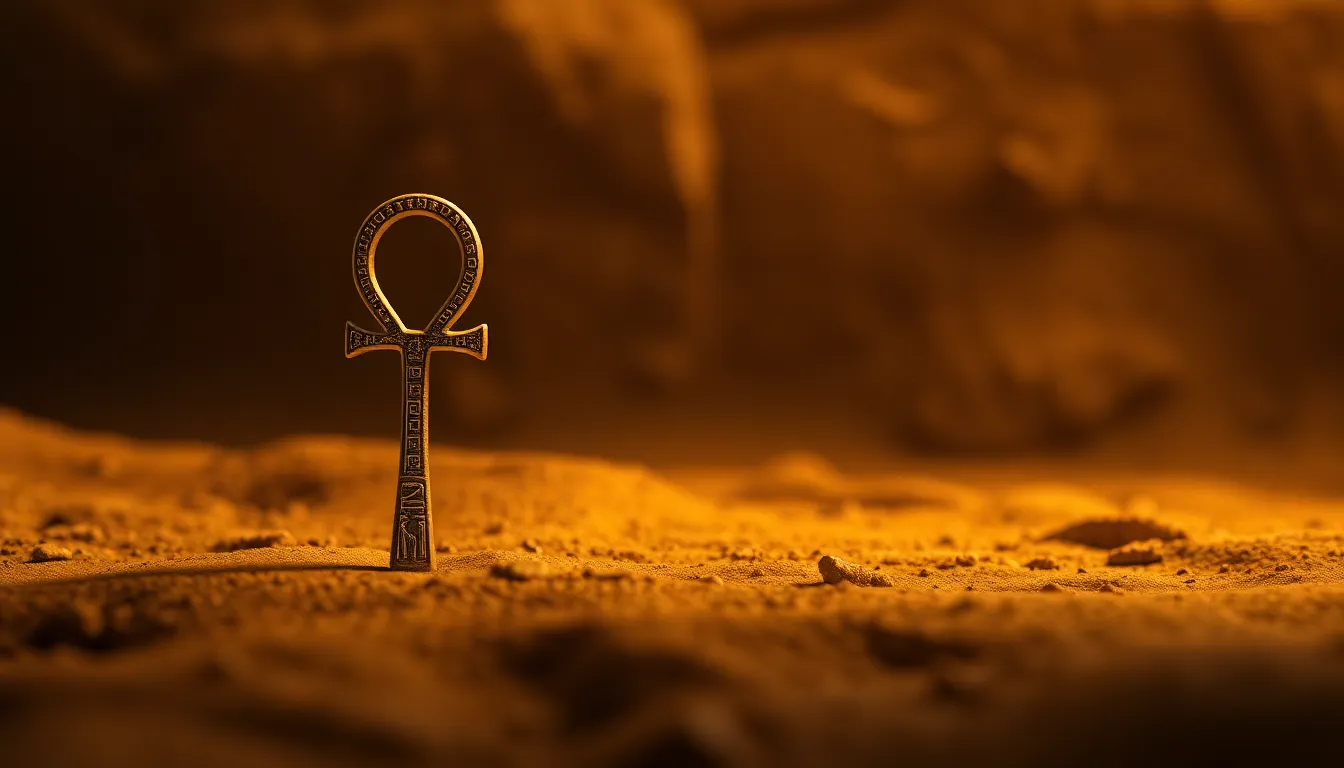The Symbolism of the Ankh: Key to Life and the Gods
I. Introduction
The ankh, often recognized as a key-like symbol with a loop at the top, represents one of the most significant and enduring symbols in ancient Egyptian mythology. Defined as a hieroglyph for “life,” the ankh encapsulates the essence of existence and the divine connection between the gods and humanity.
Historically, the ankh has its origins in ancient Egypt, with its first recorded appearances dating back to the early dynastic period (c. 3100 BCE). Over centuries, it became a ubiquitous emblem found on tombs, temples, and artifacts, signifying its importance in both daily life and the afterlife.
In ancient Egyptian culture, the ankh was not just a decorative motif; it was a profound symbol of life, death, and the continuity of existence, embodying the Egyptians’ complex beliefs about the afterlife and the divine.
II. The Ankh as a Symbol of Life
Primarily, the ankh represents eternal life and immortality. Its unique shape, resembling a key, symbolizes the unlocking of life and the promise of existence beyond death. Ancient Egyptians believed that the ankh was a gift from the gods, allowing the deceased to access the realm of the afterlife.
Moreover, the ankh is deeply connected to the cycle of life and death. It serves as a reminder of the natural order and the belief that life is cyclical, with death merely a transition to another form of existence. This profound connection is reflected in various funerary practices, where the ankh was often included in burial items to ensure the deceased’s safe passage to the afterlife.
- In tombs, the ankh was commonly inscribed or placed with the deceased.
- It was used in rituals to invoke blessings and protection for the living and the dead.
- The ankh often appeared in the hands of gods and goddesses, signifying their role as givers of life.
III. The Ankh and Deities of Ancient Egypt
The ankh is closely associated with several major gods and goddesses in ancient Egyptian mythology. Notably:
1. Osiris and the Afterlife
Osiris, the god of the afterlife, is often depicted holding the ankh, symbolizing his dominion over life and death. His resurrection and eternal life narrative resonate with the ankh’s symbolism, reinforcing its association with immortality.
2. Isis and Fertility
Isis, the goddess of fertility and motherhood, is another deity frequently linked to the ankh. Her nurturing qualities and role in the resurrection of Osiris further emphasize the ankh’s representation of life-giving forces.
The ankh is prevalent in religious art and iconography, often depicted in hieroglyphs, paintings, and sculptures within temples and sacred spaces. It serves not only as a symbol of divine power but also as a representation of the interconnectedness between gods, humans, and the natural world.
IV. The Ankh in Egyptian Hieroglyphs
Linguistically, the ankh holds significant phonetic value within the hieroglyphic system. It represents the sound “ʿnḫ,” which translates to “life.” This connection between the symbol and its meaning illustrates the importance of the ankh in written communication.
In religious texts and inscriptions, the ankh often appears alongside prayers and hymns, symbolizing the wish for life and prosperity. Its presence in these texts underscores its role in communicating spiritual concepts and beliefs about existence and the afterlife.
V. The Ankh’s Influence on Modern Culture
The ankh has transcended its ancient origins, finding a place in contemporary art, fashion, and spirituality. Its striking design and profound meaning have led to its adoption in various forms:
- In modern art, the ankh is often used as a motif to explore themes of life, death, and resurrection.
- In fashion, it appears as jewelry, tattoos, and clothing, symbolizing a connection to ancient wisdom.
- New Age spirituality has embraced the ankh, viewing it as a powerful symbol for personal empowerment and spiritual growth.
Additionally, the ankh has emerged as a symbol of feminism and empowerment, representing the life-giving and nurturing aspects traditionally associated with femininity.
VI. The Ankh in Comparative Symbolism
Throughout history, various cultures have developed symbols that resonate with the themes represented by the ankh. For instance:
- The cross in Christianity symbolizes eternal life and resurrection.
- The lotus flower in Eastern religions represents purity and the cycle of life.
- Other life symbols, such as the tree of life, emphasize interconnectedness and the continuum of existence.
These symbols, while distinct, share a unifying theme of life, death, and rebirth, highlighting the ankh’s role as a timeless emblem of human experience across different cultures and eras.
VII. Interpretations and Misinterpretations of the Ankh
Despite its rich history, the ankh is often subject to misunderstandings and myths. Common misconceptions include:
- Viewing the ankh solely as a fashion statement without understanding its cultural significance.
- Confusing the ankh with other symbols, such as the cross, without recognizing their unique meanings.
Academically, the ankh is studied as a complex symbol that reflects the spiritual and cultural beliefs of ancient Egyptians. Its representation in popular media often lacks depth, resulting in misrepresentation and oversimplification of its significance.
VIII. Conclusion
In summary, the ankh is a powerful symbol that encapsulates the essence of life, death, and the divine connection within ancient Egyptian culture. Its significance extends beyond antiquity, influencing modern spirituality and artistic expression.
The enduring legacy of the ankh invites us to explore its meanings within our own spiritual journeys, encouraging a deeper understanding of life and existence. As we delve into the mysteries of the ankh, we can discover its relevance in our personal spirituality and the broader context of cultural symbolism.
We invite you to explore further the ankh’s rich history and its implications for your own life and beliefs.




